14.3.3: Other Sulfide Minerals
- Page ID
- 18657
| Other Sulfides | |
| pentlandite (Ni,Fe)9S8 molybdenite MoS2 millerite NiS cinnabar HgS covellite CuS chalcocite Cu2S argentite (acanthite) Ag2S pyrite FeS2 cobaltite (Co,Fe)AsS |
marcasite FeS2 arsenopyrite FeAsS skutterudite (Co,Ni)As3 stibnite Sb2S3 tetrahedrite Cu12Sb4S13 pyrargyrite (ruby silver) Ag3SbS3 orpiment As2S3 realgar AsS |
The eight sulfides just discussed and several other less important ones have relatively simple structures based on closest packing and metal ions occupying either tetrahedral or octahedral sites, but not both. Pentlandite, the most important ore mineral of nickel, is the only common sulfide containing metal atoms in both coordinations. Many other sulfides, including those listed in the blue box, have more complex structures. Metal ions may be in 5-fold or other unusual coordinations, they may occupy several different sites in the structures, and the sites may be highly polarized or distorted. Below we look at some of these other sulfides.
For more general information about sulfide minerals, see the discussion in Chapter 9.
Pentlandite (Ni,Fe)9S8
Origin of Name
Named after J. B. Pentland (d. 1873), a geologist working in Sudbury, Ontario, Canada, who first described the mineral.
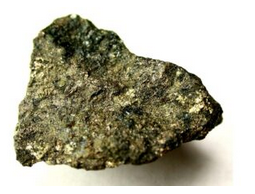
Hand Specimen Identification
Metallic luster, bronze-yellow color and association help identify pentlandite, but distinguishing it from other golden or brassy minerals is problematic without chemical analysis. It resembles pyrrhotite in appearance but is not magnetic. Often the two minerals are found together; Figure 14.268 shows an example from Norway. In this specimen, pentlandite has a shiny metallic gold/brass color. The pyrrhotite is tarnished and has a much duller luster.
Physical Properties
| hardness | 3.5 to 4 |
| specific gravity | 5.0 |
| cleavage/fracture | perfect {100}, good octahedral {111}/uneven |
| luster/transparency | metallic/opaque |
| color | bronze to yellow-bronze |
| streak | light bronze to brown |
Crystallography
Pentlandite is cubic, a = 10.05, Z = 4; space group \(F\dfrac{4}{m}\overline{3}\dfrac{2}{m}\); point group \(\dfrac{4}{m}\overline{3}\dfrac{2}{m}\).
Habit
Coarse crystals are very rare. Pentlandite is usually massive or in granular aggregates. Sometimes {111} parting develops.
Structure and Composition
Pentlandite has a complicated face-centered cubic structure. The basic structure consists of (Ni,Fe)S6 octahedra sharing corners. Additional Ni and Fe occupy distorted tetrahedral sites between the octahedra. Co commonly substitutes for (Ni,Fe). Mn and Cu are other common impurities.
Occurrence and Associations
Pentlandite, the most important nickel ore mineral, is found in late-stage sulfide deposits with other nickel minerals (millerite, niccolite), pyrrhotite, and chalcopyrite. Pentlandite often occurs as exsolved blebs and lamellae within pyrrhotite.
Related Minerals
Pentlandite forms solid solutions with cobalt pentlandite, Co9S8. It is isostructural with a number of minerals, including argentopentlandite, Ag(Fe,Ni)8S8. Other related minerals are bornite, Cu5FeS, and niccolite, NiAs.
Molybdenite MoS2
Origin of Name
From the Greek word molybdos, meaning “lead,” which refers to a misidentification by early mineralogist
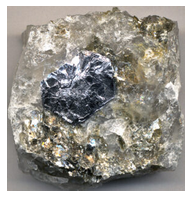
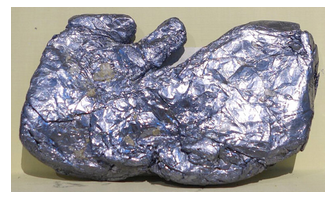
Hand Specimen Identification
Metallic luster, silver/gray color, softness, flexibility, and basal cleavage identify molybdenite. It sometimes resembles graphite, another mineral that may occur as silver/gray metallic hexagonal crystals. Figure 14.269 shows a hexagonal flake of molybdenite in quartz.
Molybdenite, like the flake in the photo above, often appears more metallic than graphite. Additionally, graphite‘s color and streak are black to gray; molybdenite‘s color and streak may be more bluish gray. Molydenite is often anhedral and massive; the specimen seen in Figure 14.270 is an example. Figure 9.35 is a photo of another example of massive molybdenite.
Physical Properties
| hardness | 1 to 1.5 |
| specific gravity | 4.7 |
| cleavage/fracture | perfect basal (001)/flexible |
| luster/transparency | metallic/opaque |
| color | silver, lead-gray, sometimes with a hint of blue |
| streak | gray or blue-gray |
Crystallography
Molybdenite is hexagonal, a = 3.16, c = 12.32, Z = 2; space group \(P\dfrac{6_3}{m}\dfrac{2}{m}\dfrac{2}{m}\); point group \(\dfrac{6}{m}\dfrac{2}{m}\dfrac{2}{m}\).
Habit
Molybdenite crystals form hexagonal plates or stubby prisms. Foliated or scaly aggregates are flexible, but not elastic.
Structure and Composition
The molybdenite structure involves two sheets of S, arranged in a hexagonal pattern, sandwiching a sheet of Mo atoms. Each Mo atom is bonded to three S in each of the two sheets. The three-layer units are stacked up to produce the entire structure. Molybdenite is usually quite close to its stoichiometric composition but may contain traces of Au, Ag, Re, and Se.
Occurrence and Associations
Molybdenite occurs as an accessory mineral in some granitic rocks, including pegmatites. It also is found in porphyry copper deposits; in vein deposits with scheelite, cassiterite, wolframite, and fluorite; and in some contact aureoles.
Millerite NiS
Origin of Name
Named after W. H. Miller (1801–1880), who was the first to study the crystals.
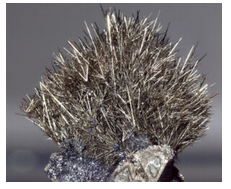
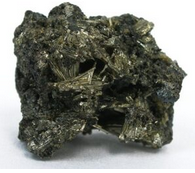
Hand Specimen Identification
Millerite is easily recognized if it forms radiating acicular crystals, and it often does (Figure 14.271). The specimen seen in Figure 14.272 also contains needles of millerite but they are coarser and do not appear to radiate. Luster, brass-yellow color (if present), and rhombohedral cleavage also aid identification. Otherwise, identification may be problematic.
Physical Properties
| hardness | 3 to 3.5 |
| specific gravity | 5.5 |
| cleavage/fracture | perfect {101} and {012}/uneven |
| luster/transparency | metallic/opaque |
| color | bronze, greenish gray, gray, or brass yellow |
| streak | greenish black, green-gray |
Crystallography
Millerite forms trigonal crystals. a = 9.62, c = 3.15, Z = 9; space group R3m; point group 3m.
Habit
Crystals are typically acicular or filiform. Millerite may form radiating sprays or velvety crusts.
Structure and Composition
The structure of millerite is a complex derivative of the niccolite structure. Both Ni and S are in 5-fold coordination. Co, Fe, and As are minor impurities.
Occurrence and Associations
Millerite is a low-temperature mineral that forms as a replacement for other nickel minerals or in cavities. It is associated with calcite, fluorite, dolomite, hematite, siderite, pyrrhotite, and chalcopyrite.
Related Minerals
Millerite has structural similarity with niccolite, NiAs, and with pyrrhotite, Fe1-xS. A high-temperature polymorph exists above 379 °C (714 °F).
Cinnabar HgS
Origin of Name
The origin of the name is uncertain.
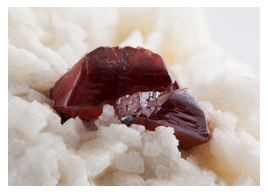
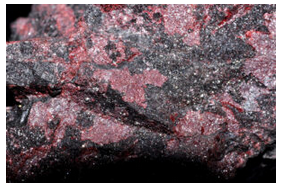
Hand Specimen Identification
High density, red color, and streak identify cinnabar, the most common mercury mineral. It may be confused with hematite, cuprite, or realgar, mostly due to its red color.
Figure 14.273 show euhedral cinnabar crystals on top of dolomite. Most cinnabar, however, is massive like the cinnabar seen in Figure 14.274. The photo also contain blebs of silvery native mercury (a liquid). The specimen comes from a famous mercury mine district in Almaden, Spain.
Physical Properties
| hardness | 2.5 |
| specific gravity | 8.1 |
| cleavage/fracture | perfect prismatic {100}/ subconchoidal |
| luster/transparency | adamantine/transparent to translucent |
| color | bright red to brownish red |
| streak | scarlet |
Properties in Thin Section
Cinnabar is uniaxial (+), ω = 2.90, ε = 3.25, δ = 0.35.
Crystallography
Cinnabar crystals are trigonal. a = 4.15, c = 9.50, Z = 3; space group P312; point group 32.
Habit
Rare cinnabar crystals are rhombohedral, thick tabs or prisms; less commonly acicular. Most occurrences are granular or earthy masses; often they are crusty, sometimes disseminated.
Structure and Composition
Cinnabar’s structure consists of Hg-S-Hg chains spiraling parallel to the c-axis. It is usually close to HgS in composition; only traces of other elements are present.
Occurrence and Associations
Cinnabar is the most significant Hg ore mineral. It is found as masses in volcanic or sedimentary rocks, in veins, or as disseminated grains. Associated minerals include native mercury, realgar, stibnite, pyrite, marcasite, calcite, quartz, and opal.
Related Minerals
Metacinnabar (cubic) and hypercinnabar (hexagonal) are polymorphs of cinnabar. Other related mercury minerals include coloradoite (HgTe), and tiemannite (HgSe).
Covellite CuS
Origin of Name
Named after N. I. Covelli (1790–1829), who discovered Vesuvian covellite.
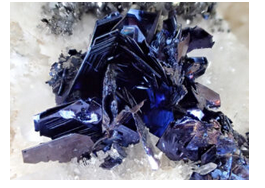
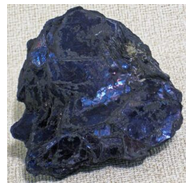
Hand Specimen Identification
High density, shiny luster, distinctive indigo-blue color, and association identify covellite. The photos seen here show two examples of covellite from Butte, Montana, where significant amounts of copper were produced from the late 1800s to around 1983. Euhedral crystals, such as those seen in Figure 14.275 are rare but spectacular. Figure 9.38 shows another example from Butte.
Physical Properties
| hardness | 1.5 to 2 |
| specific gravity | 4.6 |
| cleavage/fracture | perfect basal (001)/conchoidal |
| luster/transparency | metallic/opaque |
| color | indigo-blue; purplish tarnish |
| streak | dark gray to black |
Crystallography
Covellite crystals are hexagonal, a = 3.80, c = 16.36, Z = 6; space group \(P\dfrac{6_3}{m}\dfrac{2}{m}\dfrac{2}{c}\); point group \(\dfrac{6}{m}\dfrac{2}{m}\dfrac{2}{m}\).
Habit
Rare hexagonal crystals are tabular or platy; covellite is usually in massive or foliated aggregates or in overgrowths and coatings on other copper minerals.
Structure and Composition
In covellite, covalent sulfur bonds link layers of CuS4 tetrahedra. Weak bonds between the layers result in excellent planar cleavage. Fe often replaces some Cu; Se replaces some S.
Occurrence and Associations
Primarily a secondary (supergene) mineral, covellite occurs with other Cu sulfides in veins or disseminated deposits. Associated minerals include bornite, chalcopyrite, chalcocite, and enargite.
Related Minerals
Covellite is similar in some ways to klockmannite (CuSe), with which it forms solid solutions.
Chalcocite Cu2S
Origin of Name
From the Greek word chalkos, meaning “copper.”

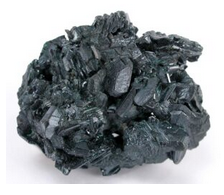
Hand Specimen Identification
Gray, often sooty color with a blue tarnish, luster, hardness, sectile nature, and density may identify chalcocite. Association with other copper minerals is helpful, but otherwise chalcocite can be confused with other gray nondescript minerals.
The photo on the left (Figure 14.277) shows a sample of massive chalcocite from Bisbee, Arizona, where copper was mined from about 1875 to 1975. The photo on the right (Figure 14.278) contains a mass of euhedral chalcocite crystals from Queensland, Australia.
Physical Properties
| hardness | 2.5-3 |
| specific gravity | 5.8 |
| cleavage/fracture | poor prismatic {110}/ conchoidal |
| luster/transparency | metallic/opaque |
| color | blue-white, shining lead-gray, dull sooty gray |
| streak | grayish black |
Crystallography
Chalcocite is monoclinic, a = 15.25, b = 11.88, c = 13.49, β = 116.35°, Z = 48; space group \(P\dfrac{2_1}{c}\); point group \(\dfrac{2}{m}\).
Habit
Chalcocite is usually fine grained and massive with conchoidal fracture. Squat prisms or tabular
crystals, sometimes with a hexagonal outline, and sometimes displaying striations, are rare.
Structure and Composition
Chalcocite‘s structure is based on hexagonal close packed sulfur atoms. Two-thirds of the Cu atoms occupy trigonal sites within sulfur planes; the other third is in octahedral coordination between planes. Fe and Ag are common replacements for Cu; Se may replace some S.
Occurrence and Associations
Chalcocite is a common primary or secondary copper ore mineral. It occurs both in veins and in altered zones. Associated primary minerals include bornite, chalcopyrite, enargite, galena, tetrahedrite, cuprite, and pyrite. Covellite, malachite, or azurite are common alteration products.
Related Minerals
Normal chalcocite is monoclinic, but a hexagonal polymorph exists at elevated temperatures. Solid solution with berzelianite (Cu2Se) is common. Similar minerals include stromeyerite (AgCuS) and digenite (Cu2-xS).
Argentite (Acanthite) Ag2S
Origin of Name
From the Latin word argentum, which means “silver.”

Hand Specimen Identification
High density, metallic or submetallic luster, dark color, and sectile nature may identify argentite. It can be confused with chalcocite and tetrahedrite which are metallic minerals with a similar color. The arborescent habit seen in Figure 14.279, when present, helps identify this mineral.
Physical Properties
| hardness | 2 to 2.5 |
| specific gravity | 7.1 |
| cleavage/fracture | poor cubic {100}/subconchoidal |
| luster/transparency | metallic/opaque |
| color | lead-gray to black |
| streak | black or shiny black |
Crystallography
Argentite is cubic, a = 4.89, Z = 2; space group \(I\dfrac{4}{m}\overline{3}\dfrac{2}{m}\); point group \(\dfrac{4}{m}\overline{3}\dfrac{2}{m}\).
Habit
Wiry, branching, columnar, and massive habit are common. Argentite crystals are cubes, octahedra, dodecahedra, or combinations. Penetration twins are common.
Structure and Composition
In argentite, sulfur atoms are arranged in a distorted body-centered arrangement. Ag atoms occupy 2-fold and 3-fold sites between S.
Occurrence and Associations
Argentite, an important Ag ore mineral, is found in veins associated with other silver minerals, galena, sphalerite, tetrahedrite, and Co-Ni sulfides.
Related Minerals
Argentite has both high-temperature and low-temperature polymorphs. Argentite is the proper name of the high-temperature cubic polymorph, and acanthite is the name of the low-temperature monoclinic polymorph. However, because low-temperature Ag2S is usually twinned, appearing pseudocubic, it is also commonly referred to as argentite. Other related silver minerals include hessite (Ag2Te), petzite (Ag3AuTe), fischesserite (Ag3AuSe2), naumannite (Ag2Se), eucairite (CuAgSe), jalpaite (Ag3CuS2), and aguilarite (Ag4SeS).
Pyrite FeS2
Origin of Name
From the Greek word pyr, meaning “fire,” because it sparks when struck by steel. Pyrite has many different appearances and habits. The photos below show some spectacular examples.
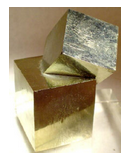

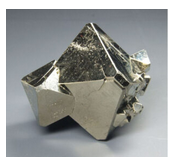

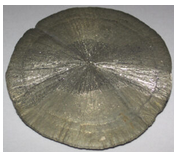
Euhedral pyrite crystals are most commonly cubes, such as those seen in the Figures 14.280 and 14.281. Other cubic forms are possible, including octahedra (Figure 14.282). This mineral is often found with other sulfide minerals; Figure 14.283 shows pyrite with galena. Figure 14.284 is a photo of an unusual pyrite form called a sun dollar. Sun dollars develop when pyrite crystallizes in restricted space between layers of high-grade coal.
Hand Specimen Identification
Density, metallic luster, brass-yellow color, and hardness identify pyrite. It is sometimes confused with chalcopyrite and marcasite, both of which have slightly different colors. Pyrite is also called fools gold, but has a more metallic brassy color than gold, and pyrite has a greenish-black streak, while gold has a yellow streak.
Physical Properties
| hardness | 6 to 6.5 |
| specific gravity | 5.1 |
| cleavage/fracture | poor {100}/subconchoidal |
| luster/transparency | metallic/opaque |
| color | brass-yellow |
| streak | greenish black to green-gray |
Crystallography
Pyrite is cubic, a = 5.42, Z = 4; space group \(I\dfrac{2_1}{a}\overline{3}\); point group \(\dfrac{2}{m}\overline{3}\).
Habit
Pyrite crystals are typically cubes, pyritohedra, or octahedra. Striated faces, combinations of forms, and penetration twinning, sometimes producing iron cross twins, are common.
Structure and Composition
Pyrite‘s structure is closely related to that of NaCl; Fe and S2 alternate in a three-dimensional cubic array. Pyrite commonly contains some Ni and Co as replacements for Fe. Cu, V, Mo, Cr, W, Au, or Tl may also be present.
Occurrence and Associations
Pyrite, the most common and widespread sulfide mineral, is often called fool’s gold. It is an accessory mineral in many igneous, sedimentary, and metamorphic rocks. It is common in all sulfide deposits, associated with a wide variety of ore minerals. It also replaces organic material in coal, wood, or shells.
Related Minerals
Marcasite is an orthorhombic polymorph of pyrite. Pyrite forms solid solutions with vaesite, NiS2, and cattierite, CoS2. Cobaltite, CoAsS, and hauerite, MnS2, are isostructural with pyrite. Many other minerals are isotypical with pyrite. Other related minerals include arsenoferrite, FeAs2; pyrrhotite and mackinawite, both Fe1-xS; greigite, Fe3S4; and smythite, (Fe,Ni)9S11.
Cobaltite (Co,Fe)AsS
Origin of Name
From the German word kobold, meaning “goblin,” because early miners found it difficult to mine.
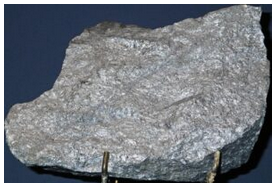

Hand Specimen Identification
Density, luster, whitish color, cleavage, and habit may identify cobaltite. A subtle to quite noticeable pinkish hue (due to tarnishing) help identification. It is sometimes confused with skutterudite.
Figure 14.285 shows cobaltite from a cobalt and silver mining district in northern Ontario. The silver-colored specimen has a slight pinkish tinge. Figure 14.286 shows tarnished cobaltite from Sweden.
Physical Properties
| hardness | 5.5 |
| specific gravity | 6.3 |
| cleavage/fracture | good cubic {100}/uneven |
| luster/transparency | metallic/opaque |
| color | tin-white or silver-white most commonly, occasionally reddish or pink |
| streak | gray-black |
Crystallography
Cobaltite is orthorhombic, a = 5.58, b = 5.58, c = 5.58, Z = 4; space group Pa2c; space group Pca21; point group mm2.
Habit
Cobaltite is usually massive. Aggregates may be granular or compact. Rare individual crystals are pseudocubic, similar in form to pyrite.
Structure and Composition
Cobaltite is isostructural with pyrite. Co replaces much of the Fe, and As replaces half the S. Fe and Ni commonly substitute for Co; Sb substitutes for As.
Occurrence and Associations
Cobaltite is commonly found with other cobalt and nickel sulfides, arsenides, and related minerals. Pyrrhotite, chalcopyrite, galena, and magnetite are also associated minerals. It may be veined or disseminated. Cobaltite is also found in a few rare metamorphic rocks.
Related Minerals
Cobaltite forms solid solutions with gersdorffite, NiAsS; ullmanite, NiSbS; and willyamite, (Co,Ni)SbS. Other similar minerals include hollingworthite, (Rh,Pt,Pd)AsS; irarsite, (Ir,Ru,Rh,Pt)AsS; platarsite, (Pt, Rh,Ru)AsS; and tolovkite, IrSbS.
Marcasite FeS2
Origin of Name
From Markashitu, an ancient province of Persia.
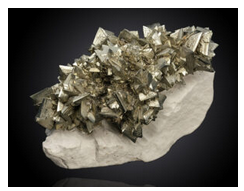
Hand Specimen Identification
Metallic luster, pale brass-yellow color, and orthorhombic habit identify marcasite. “Cockscomb” groups of twinned crystals are diagnostic. Figure 14.287 shows a mass of golden coxcomb marcasite crystals. Marcasite may be confused with its cubic polymorph, pyrite, if crystals are not well-developed and easily seen.
Physical Properties
| hardness | 6 to 6.5 |
| specific gravity | 4.9 |
| cleavage/fracture | poor {101}/uneven |
| luster/transparency | metallic/opaque |
| color | white-green to pale bronze yellow, often slightly tarnished |
| streak | grayish black |
Crystallography
Marcasite is orthorhombic, a = 4.44, b = 5.41, c = 3.38, Z = 2; space group \(\dfrac{2_1}{n}\dfrac{2_1}{n}\dfrac{2_1}{m}\); point group \(\dfrac{2}{m}\dfrac{2}{m}\dfrac{2}{m}\).
Habit
Crystal of marcasite are typically tabular, often with curved faces, showing orthorhombic symmetry. They combine to form needle-like groups, sometimes radiating, colloform, globular, reniform, or stalactitic. Twinning often produces cockscomb aggregates.
Structure and Composition
Zigzagging FeS2 chains run parallel to the c-axis; FeS6 octahedra share corners and edges. Marcasite is nearly pure FeS2; traces of Cu may be present.
Occurrence and Associations
Marcasite is a low-temperature mineral found in sulfide veins with lead and zinc minerals or as a replacement mineral in limestones or shale. Common associates are galena, pyrite, chalcopyrite, calcite, and dolomite.
Related Minerals
Pyrite is a more stable polymorph of marcasite. Isostructural minerals include hastite, CoSe2; ferroselite, FeSe2; frohbergite, FeTe2; kullerudite, NiSe2; and mattagamite, CoTe2.
Arsenopyrite FeAsS
Origin of Name
Named for its composition.
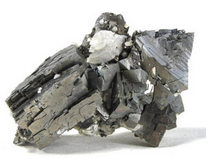
Hand Specimen Identification
Metallic luster, silver-white to gray color, and crystal shape help identify arsenopyrite. It may be confused with marcasite, pyrite, or skutterudite, but color distinguishes it from the first two, and crystal shape and habit from the latter. Arsenopyrite sometimes smells like garlic when struck with a hammer or other hard object. Figure 14.288 shows arsenopyrite with calcite.
Physical Properties
| hardness | 5.5 to 6 |
| specific gravity | 6.1 |
| cleavage/fracture | good (101)/uneven |
| luster/transparency | metallic/opaque |
| color | silver-white to gray |
| streak | black |
Crystallography
Arsenopyrite is monoclinic, a = 5.76, b = 5.69, c = 5.785, β = 112.2°, Z = 4; space group \(P\dfrac{2_1}{c}\); point group \(\dfrac{2}{m}\).
Habit
Prismatic, striated crystals of arsenopyrite are typical. Penetration, contact, and cyclic twins are common. It may be disseminated, massive, or granular.
Structure and Composition
Arsenopyrite‘s structure is similar to the atomic arrangement in marcasite with half the S replaced by As. FeAs3S3 octahedra share vertices and edges. As:S ratios vary slightly, but arsenopyrite is always close to FeAsS in composition. Minor Co and Bi may replace Fe and other elements may be present in trace amounts.
Occurrence and Associations
Arsenopyrite, the most abundant and widespread arsenic mineral, is found in Fe, Cu, Sn, Co, Ni, Ag, Au, and Pb ores. It occurs in veins, pegmatites, contact aureoles, or as disseminations in low- to medium-grade metamorphic rocks. Common associated minerals include chalcopyrite, pyrite, sphalerite, cassiterite, and gold and silver minerals.
Related Minerals
Arsenopyrite forms solid solutions with glaucodot, (Co,Fe)AsS. It is isotypical with marcasite, FeS2, and with gudmundite, FeSbS. Other related arsenic minerals include lautite, CuAsS; osarsite, (Os,Ru)AsS; and ruarsite, RuAsS.
Skutterudite (Co,Ni)As3
Origin of Name
From the type locality at Skutterude, Norway.
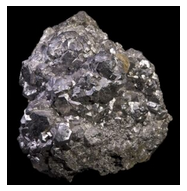
Hand Specimen Identification
The skutterudite series contains a number of related minerals; they have similar properties and are difficult to tell apart. Density, luster, and color help with identification, but chemical or X-ray analysis may be needed. Skutterudite is sometimes confused with arsenopyrite or cobaltite. Figure 14.289 shows an example of skutterudite ore from Morocco.
Physical Properties
| hardness | 5.5 to 6 |
| specific gravity | 6.1 to 6.8 |
| cleavage/fracture | good (101)/uneven |
| luster/transparency | metallic/opaque |
| color | tin-white to silver-gray |
| streak | black |
Crystallography
Skutterudite is cubic, a = 8.20, Z = 8; space group \(F\overline{4}3m\); point group \(\overline{4}3m\).
Habit
Cubes and octahedra are common forms. Skutterudite usually forms dense to granular aggregates.
Structure and Composition
In skutterudite, Co and Ni, in octahedral coordination, are linked to square AsS4 groups. Fe and Bi may substitute for Co or Ni. Some As may be missing or replaced by S or Sb.
Occurrence and Associations
Skutterudite is a vein mineral associated with other Co and Ni minerals such as cobaltite or niccolite. Other associated minerals include arsenopyrite, native silver, silver sulfosalts, native bismuth, calcite, siderite, barite, and quartz.
Related Minerals
The three important members of the skutterudite series are skutterudite, (Co,Ni)As3; smaltite, (Co,Ni)As3; and chloanthite, (Ni,Co)As3-x. Linnaeite, Co3S4, is closely related.
Stibnite Sb2S3
Origin of Name
From the Greek word stibi, a name originally used by Pliny, a first-century Greek encyclopedist and scientist.

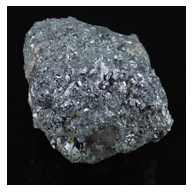
Hand Specimen Identification
Stibnite is characterized by its softness, perfect cleavage in one direction, black streak, bladed or columnar habit, and lead-gray color. Euhedral crystals often form in parallel or subparallel masses such as seen in Figure 14.290. Figure 3.22 is a photo of a similar cluster, but it is huge. It is nearly a meter across and weighs 90 kg. This habit and gray color are diagnostic for stibnite. When massive (Figure 14.291), stibnite may be confused with any of a number of other gray minerals.
Physical Properties
| hardness | 2 |
| specific gravity | 4.6 |
| cleavage/fracture | one perfect (010)/subconchoidal |
| luster/transparency | metallic/opaque |
| color | lead-gray |
| streak | lead-gray to black |
Crystallography
Stibnite is orthorhombic, a = 11.12, b = 11.30, c = 3.84, Z = 4; space group \(P\dfrac{2_1}{b}\dfrac{2_1}{n}\dfrac{2_1}{m}\); point group \(\dfrac{2}{m}\dfrac{2}{m}\dfrac{2}{m}\).
Habit
Prismatic striated metallic-gray crystals, often slender, long, and curved, typify stibnite. Faces show striations; terminating faces may be steep. Typically, stibnite is found in aggregates containing granular to coarse columns or needles.
Structure and Composition
Stibnite‘s structure contains zigzagging chains of Sb2S3 parallel to the c-axis Small amounts of other metals may replace Sb. Fe, Pb, and Cu are the most common impurities. Ag, Au, Zn, and Co may also be present in trace amounts.
Occurrence and Associations
Stibnite is found in hydrothermal veins, in replacement deposits, and more rarely, in hot spring deposits. Typical associates include orpiment, realgar, cinnabar, galena, sphalerite, pyrite, barite, and sometimes gold.
Related Minerals
Bismuthinite, Bi2S3, and guanajuatite, Bi2Se3, are isostructural with stibnite.
Tetrahedrite Cu12Sb4S13
Origin of Name
Named for its typical crystal shape.

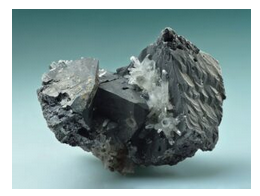
Hand Specimen Identification
Crystals shaped like tetrahedra (Figure 14.292), lack of cleavage, and silver to black color help identify a number of minerals that belong to the tetrahedrite series, Cu12(Sb,As)4S13. The different minerals, however, cannot be told apart without chemical analysis or X-ray study. Besides tetrahedra, other cubic forms are possible; Figure 14.293, for example, is a photo of cube-shaped tetrahedrite crystals.
Physical Properties
| hardness | 3 to 4.5 |
| specific gravity | 4.5 to 5.1 |
| cleavage/fracture | none/subconchoidal |
| luster/transparency | metallic/opaque |
| color | silver or grayish black to black |
| streak | brown to black |
Crystallography
Tetrahedrite is cubic, a = 10.34, Z = 2; space group \(I\overline{4}3m\); point group \(\overline{4}3m\).
Habit
Tetrahedrite crystals are typically tetrahedra, sometimes with modifying faces. Penetration twins are common. Crystal aggregates may be massive or granular.
Structure and Composition
The structure of tetrahedrite is similar to that of sodalite. CuS4 tetrahedra share corners. Sb or As occupy openings between the tetrahedra. Fe, Zn, Pb, Ag, and Hg may replace Cu. Complete solid solution exists between end members tetrahedrite, Cu12Sb4S13, and tennantite, Cu12As4S13.
Occurrence and Associations
Tetrahedrite, one of the most common sulfosalts, is found in veins and in replacement deposits. Associated minerals include chalcopyrite, sphalerite, galena, pyrite, argentite, and many other minerals.
Varieties
Freibergite is a Ag-rich variety of tetrahedrite. Schwatzite is an Hg-rich variety.
Related Minerals
Tennantite, Cu12As4S13, is isostructural with tetrahedrite. Other related minerals include germanite, Cu3(Ge,Fe)S4; colusite, Cu3(As,Sn,Fe)S4; and sulvanite, Cu3VS4.
Pyrargyrite (Ruby Silver) Ag3SbS3
Origin of Name
From the Greek words meaning “fire” and “silver,” relating to its color and composition.
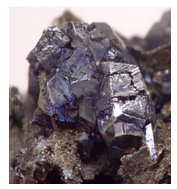
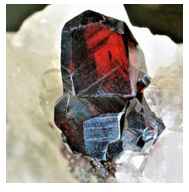
Hand Specimen Identification
Distinctive red color, translucence, and density may identify pyrargyrite. It is commonly found with other silver-bearing minerals.
Pyrargyrite may be confused with proustite but generally has a ruby-red color, while proustite is more vermillion. It is occasionally mistaken for cuprite which is typically brownish red to purple. Figures 14.294 and 14.295 show two examples.
Physical Properties
| hardness | 2 |
| specific gravity | 5.85 |
| cleavage/fracture | good {101}/subconchoidal |
| luster/transparency | adamantine/translucent |
| color | ruby-red to deep red-purple to purple |
| streak | red to purple |
Properties in Thin Section
Pyrargyrite is uniaxial (-), ω = 3.08, ε = 2.88, δ = 0.20.
Crystallography
Pyrargyrite is hexagonal (trigonal), a = 11.06, c = 8.73, Z = 6; space group R3c; point group 3m.
Habit
Pyrargyrite most commonly forms trigonal striated prismatic crystals. Simple, repeated, and cyclic twins are common. Aggregates may be massive or granular.
Structure and Composition
Pyrargyrite‘s structure is composed of three S bonded to Sb to form pyramids. Ag occupies large sites between the pyramids. Cu may replace Ag; As and Bi may replace Sb.
Occurrence and Associations
Pyrargyrite is found in low-temperature veins and in replacement deposits. Associated minerals include native silver, argentite, tetrahedrite, galena, sphalerite, carbonates, and quartz.
Related Minerals
Pyrargyrite has two polymorphs: pyrostilpnite and xanthoconite. Proustite, Ag3AsS3, is isostructural with pyrargyrite, but solid solutions are limited. Both pyrargyrite and proustite are called ruby silvers.
Orpiment As2S3
Origin of Name
From the Latin word aurum and pigmentum, meaning “golden paint,” referring to its color.


Hand Specimen Identification
Orpiment is one of the few yellow non-metallic minerals. Its foliated structure and hardness help identify it. When visible, perfect cleavage distinguishes it from sulfur – which sometimes has a similar appearance and habit. Odor, too (sulfur smells) helps make the distinction.
Orpiment has a yellow color, but it is almost always found with realgar, a red-pink mineral with just about the same composition. Figure 14.296 shows orpiment (yellow) with minor realgar (pinkish). The specimen seen in Figure 14.297 is mostly realgar with a lesser amount of orpiment on the sides.
Physical Properties
| hardness | 1.5 to 2 |
| specific gravity | 3.49 |
| cleavage/fracture | one perfect (010)/even or sectile |
| luster/transparency | resinous, also pearly on cleavage face/translucent |
| color | lemon-yellow to orange-yellow |
| streak | pale yellow to yellow |
Properties in Thin Section
Orpiment is biaxial (-) a = 2.40 , β = 2.81, δ = 3.02, 2V = 76°.
Crystallography
Orpiment is monoclinic, a = 11.49, b = 9.59, c = 4.25, β = 90.45°, Z = 4; space group R3c; point group 3m.
Habit
Rare crystals of orpiment are small, tabular, or prismatic, often poorly formed. Columnar or foliated aggregates are common.
Structure and Composition
In orpiment, AsS3 pyramids share edges, producing 6-member rings. Crumpled layers of rings are stacked on top of each other.
Occurrence and Associations
Orpiment, a rare mineral found in hot spring deposits and some gold deposits, is commonly associated with realgar. Other associated minerals include stibnite, native arsenic, calcite, barite, and gypsum.
Related Minerals
Getchellite, AsSbS3, is similar in structure to orpiment. Realgar, AsS, is closely related in composition.
Realgar AsS
Origin of Name
From the Arabic phrase rahj al-ghar, meaning “powder of the mine.”
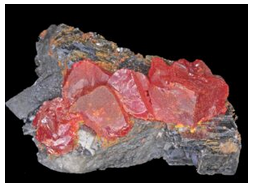
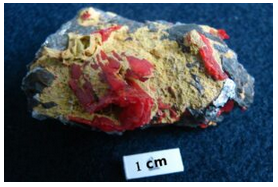
Hand Specimen Identification
Association with orpiment, resinous luster, orange-red streak, and red color identify realgar. It is sometimes confused with cinnabar, cuprite, or hematite because of its red color.
Figure 14.298 shows vermillion-colored realgar on top of galena. Minor orangish orpiment is also present. Figure 14.299 shows redder realgar with yellow orpiment and gray galena. See also Figure 14.297, above.
Physical Properties
| hardness | 1.5 to 2 |
| specific gravity | 3.56 |
| cleavage/fracture | good (010)/conchoidal |
| luster/transparency | resinous/transparent to translucent |
| color | red to orange |
| streak | red to orange |
Properties in Thin Section
Realgar is biaxial (-), α = 2.538 , β = 2.864, γ = 2.704, δ = 0.166, 2V = 41°.
Crystallography
Realgar is monoclinic, a = 9.29, b = 13.53, c = 6.57, β = 106.55°, Z = 4; space group \(P\dfrac{2_1}{n}\); point group \(\dfrac{2}{m}\).
Habit
Realgar may form short prismatic crystals having vertical striations. It is often massive granular or forms as earthy crusts.
Structure and Composition
Realgar contains uneven rings of As4S4 that form layers in the structure. The As atoms, lying alternately above and below the plane of the S atoms, are covalently bonded to As in adjacent layers.
Occurrence and Associations
Realgar is associated with lead, gold, and silver ores. Associated minerals include orpiment, other arsenic minerals, and stibnite.
Related Minerals
Orpiment, As2S3, is closely related in composition.


